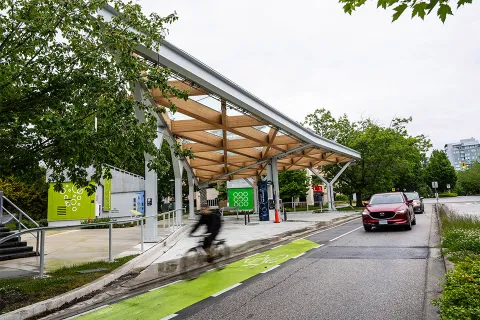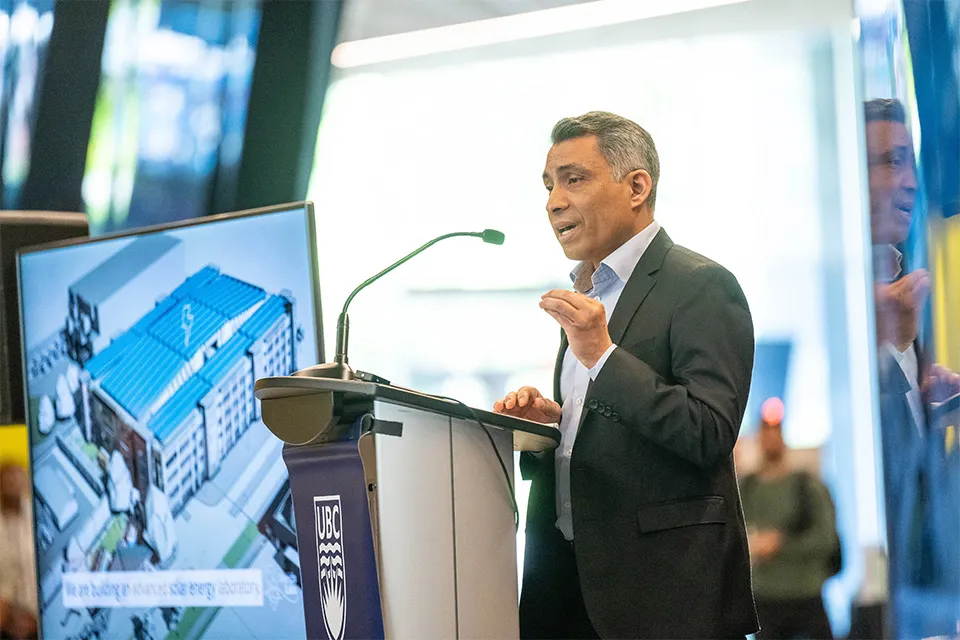New UBC engineering research facility accelerates innovation in BC’s hydrogen energy sector

BC’s hydrogen infrastructure enters a new era with today’s launch of the $23-million Smart Hydrogen Energy District (SHED) at UBC. Equipped with a hydrogen fueling station, this facility is expected to pave the way for breakthroughs in critical energy research.
SHED will produce hydrogen using solar and hydro power to operate a water electrolyser, making the process completely green and renewable. It is one of the first initiatives to combine hydro, solar and hydrogen energy at a single site, connecting these renewable energy sources to a unified micro-grid. SHED will be the province's first hydrogen station to serve light- and heavy-duty vehicles.
The Honourable Josie Osborne, Minister of Energy, Mines and Low Carbon Innovation, attended the opening today at UBC’s Vancouver campus.

“The UBC Smart Hydrogen Energy District (SHED) is yet another leap forward in building a clean economy and creating new opportunities for British Columbians,” said Minister Osborne. “By integrating energy, transportation, and design, SHED not only supports our CleanBC goals but it also positions British Columbia as a world leader in the hydrogen economy. Projects like this demonstrate our commitment to producing clean energy and ensuring a prosperous future for generations to come.”
“We are grateful to the provincial and federal governments, private sector partners and others for their critical investment in this research facility, which further strengthens UBC’s position as a global leader in climate solutions and energy systems innovation,” said UBC President and Vice-Chancellor Dr. Benoit-Antoine Bacon. “This new space gives UBC scholars significant new research and learning opportunities that will help shape our society and economy in the years ahead.”
Producing clean energy locally
“Hydrogen can play a critical role in Canada’s transition to a low-carbon economy,” said Dr. Walter Mérida, SHED research lead and professor of mechanical engineering in the Faculty of Applied Science.
“With SHED, we demonstrate hydrogen as a bridge between renewable electricity and sustainable energy services. As technologies become smart and interconnected, we can stop thinking of gas, electrical and digital networks as separate entities.”

SHED combines various technologies within a city block, serving as a model for compact urban planning. A rooftop solar array powers both the hydrogen fueling station and nearby electric vehicle charging stations. Two-way charging will enable parked EVs to both draw power from the grid and give excess stored electricity back to the grid during peak hours when there is extra energy demand.
“Cars sit in parking spaces most of the time—with the right infrastructure, they can also serve as mass power banks, stabilizing the electric grids of the future,” said Mérida.
A secure 5G network connects SHED’s different systems, enabling researchers to create digital simulations for energy, transportation and urban planning research.
Powering vital collaborations
The global hydrogen market is expected to grow significantly in the coming decades, and Canada will need sustained research to maintain and expand its leadership in hydrogen technologies, said Mérida.
“The first UBC spinoff company from this work has launched. With interest in hydrogen booming across the country, we hope SHED attracts other clean-energy innovators. Our goal is to accelerate climate solutions through insights from this project and seek industry and private sector partners for collaboration.”
SHED received generous funding from the following partners:
“UBC’s tradition of nurturing innovators continues today as we mark the grand opening of the Smart Hydrogen Energy District,” said The Honourable Harjit S. Sajjan, Minister of Emergency Preparedness and Minister responsible for the Pacific Economic Development Agency of Canada (PacifiCan). “This is one example of the ground-breaking work taking place across our province that is propelling us towards a net-zero future. With support from the Government of Canada, home-grown innovation is fueling economic growth for British Columbians today and for years to come.”



